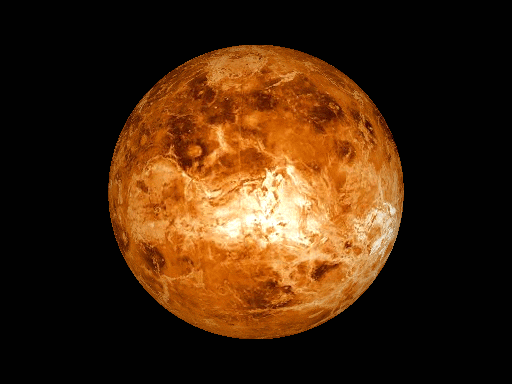


-
Venus is the brightest planet in the Solar System and can be seen even in daylight if you know where to look.
-
The word planet is from the ancient Greek word πλάνητης, planets, which means a wanderer, because they move through the stars, which seem to be fixed in the sky. This movement is because the planets are all orbiting around the sun.
-
Venus orbits round the sun in 225 days. The Earth takes 365 days to complete an orbit of the sun. So a year on Venus only lasts for 262 days!
-
Venus has phases like the moon because the orbit of Venus is between the Earth and the Sun.
-
Venus is the 2nd planet from the sun. The closest planet to the sun is Mercury.
-
The planets in the Solar system are given the names of Roman Gods or their attendants. Venus is called after the Roman Goddess of love and beauty.
-
Venus looks bigger than the Earth in figure 1 because of the very deep layer of gases that surround the planet.
-
Venus, like the other planet between the Earth and the Sun, Mercury, has no moons.


Diameter: 12,104 km
Mass: 4.87 x 10^24 kg (81.5% Earth)
Moons: None
Orbit Distance: 108,209,475 km (0.73 AU)
Orbit Period: 225 days
Surface Temperature: 462 °C
First Record: 17th century BC
Recorded By: Babylonian astronomers

Venus Diagram
Facts about Venus
-
Venus does not have any moons or rings.
-
Venus is nearly as big as the Earth with a diameter of 12,104 km.
-
Venus is thought to be made up of a central iron core, rocky mantle and silicate crust.
-
A day on the surface of Venus (solar day) would appear to take 117 Earth days.
-
A year on Venus takes 225 Earth days.
-
The surface temperature on Venus can reach 471 °C.

MORE VENUS FACTS
-
A day on Venus lasts longer than a year.
It takes 243 Earth days to rotate once on its axis (sidereal day). The planet’s orbit around the Sun takes 225 Earth days, compared to the Earth’s 365. A day on the surface of Venus (solar day) takes 117 Earth days. -
Venus rotates in the opposite direction to most other planets.
This means that Venus is rotating in the opposite direction to the Sun, this is also know as a retrograde rotation. A possible reason might be a collision in the past with an asteroid or other object that caused the planet to alter its rotational path. It also differs from most other planets in our solar system by having no natural satellites. -
Venus is the second brightest object in the night sky.
Only the Moon is brighter. With a magnitude of between -3.8 to -4.6 Venus is so bright it can be seen during daytime on a clear day. -
Atmospheric pressure on Venus is 92 times greater than the Earth’s.
While its size and mass are similar to Earth, the small asteroids are crushed when entering its atmosphere, meaning no small craters lie on the surface of the planet. The pressure felt by a human on the surface would be equivalent to that experienced deep beneath the sea on Earth. -
Venus is often called the Earth’s sister planet.
The Earth and Venus are very similar in size with only a 638 km difference in diameter, Venus having 81.5% of the Earth’s mass. Both also have a central core, a molten mantle and a crust. -
Venus is also known as the Morning Star and the Evening Star.
Early civilizations thought Venus was two different bodies, called Phosphorus and Hesperus by the Greeks, and Lucifer and Vesper by the Romans. This is because when its orbit around the Sun overtakes Earth’s orbit, it changes from being visible after sunset to being visible before sunrise. Mayan astronomers made detailed observations of Venus as early as 650 AD.